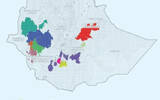The Federal Reserve cuts interest rates for the first time in 4 years! Expected to increase coffee trade
The Federal Reserve announced on September 18 that it would cut interest rates for the first time in more than four years, that is, which target range of the federal funds rate would be cut by 50 basis points to between 4.75% and 5.00%. It is reported that this is the first time that the Fed has cut interest rates since March 2020, marking a shift from the monetary tightening cycle to the easing cycle in the United States.

The Fed usually cuts interest rates only when the economy is in trouble, in an attempt to stimulate the recovery through looser monetary policy. As a result, the market is generally optimistic that the move will boost the global economic recovery and, in turn, boost the liquidity of all kinds of assets, which will have a positive impact on investors and may promote a number of industries, including food, beverage and agriculture, to attract more capital inflows.
In addition, interest rate cuts usually lead to lower global costs of capital, which may reduce financing costs for companies and individuals, including loans and investment costs. For the coffee industry, for some coffee growers or some processing enterprises can obtain funds at a lower cost and improve profitability.
Second, interest rate cuts will lead to a depreciation of the dollar, which is good news for some coffee exporters. Coffee is traded mainly through the dollar, which depreciates when some buyers or traders using other currencies can pay less for coffee beans, thus increasing the demand for coffee and benefiting exports. For some large importing countries, interest rate cuts may reduce the cost of imported coffee and stimulate demand in the coffee market.
At the same time as the Fed announced the rate cut, the Monetary Policy Committee (Copom) of the Central Bank of Brazil announced on the same day that it would raise the benchmark interest rate by a quarter of a percentage point from 10.5% to 10.75%, the first increase since Lula became president in 2023. Although the Brazilian economy faces a high rate of inflation, the central bank's decision is aimed at stabilizing the exchange rate and attracting foreign investment.

However, higher interest rates in Brazil will increase the cost of loans, which may increase the financial burden on farmers and companies that rely on loans for coffee cultivation, processing and export. In addition, due to recent days, Brazil has been in a state of severe drought, drought affected 60% of the country, a number of coffee producing areas have been threatened by fire, Brazil's coffee production in the new season has been facing the risk of decline.
According to data released by the Brazilian Institute of Geography and Statistics (IBGE), coffee production in Brazil is expected to be 59.7 million bags (60 kg / bag) in 2024, down 1.6% from previous forecasts, due to the smaller size of coffee beans and a decrease in production due to the impact of drought, but the reduction is relatively small due to the increase in coffee acreage.
While production is falling, raising interest rates will increase production costs, which could lead to a further rise in coffee prices. Recently, however, as the EU has no deforestation legislation (EUDR) to be implemented at the end of this year, EU coffee traders are increasing their purchases in order to have sufficient inventory before the implementation of EUDR.
So Brazilian coffee exports have been sizeable in recent months. According to the latest figures from the Brazilian Association of Coffee exporters (Cecafe), Brazil exported 3.733 million bags (60 kg / bag) of coffee in August, with export earnings of US $955.6 million, the best performance in August. From January to August 2024, Brazil exported a total of 31.892 million bags of coffee, an increase of 39.2% over the same period last year. Moreover, the United States is still Brazil's largest coffee market, with a total of 5.066 million bags of Brazilian coffee exported to the United States from January to August, an increase of 30.1 percent over the same period last year, so there will not be much price fluctuations in the short term.
Overall, the impact of interest rate cuts on a number of coffee-producing countries will benefit from lower bank borrowing costs and exchange rate fluctuations, reducing cost pressures. However, due to current shipping delays, container shortages, climate-affected production cuts in many countries and the upcoming zero deforestation policy in the European Union, coffee prices will remain high until at least the end of 2024.
For more information about coffee producing areas, please scan the code directly and follow: coffee comments.
Long press the QR code to follow:
TRANSLATE with
X
English
ArabicHebrewPolishBulgarianHindiPortugueseCatalanHmong DawRomanianChinese SimplifiedHungarianRussianChinese TraditionalIndonesianSlovakCzechItalianSlovenianDanishJapaneseSpanishDutchKlingonSwedishEnglishKoreanThaiEstonianLatvianTurkishFinnishLithuanianUkrainianFrenchMalayUrduGermanMalteseVietnameseGreekNorwegianWelshHaitian CreolePersian
TRANSLATE with
COPY THE URL BELOW
Back
EMBED THE SNIPPET BELOW IN YOUR SITE Bing Webmaster Portal
Back
Important Notice :
前街咖啡 FrontStreet Coffee has moved to new addredd:
FrontStreet Coffee Address: 315,Donghua East Road,GuangZhou
Tel:020 38364473
- Prev

Salmon sushi coffee specialty?! Netizen: Don't come over!
▲ Click to pay attention| Daily Boutique Coffee Culture Magazine Coffee Workshop Most people who like Japanese food are no strangers to salmon sushi. This common product in Japanese food shops is deeply loved by diners because of its unique taste. However, when this classic Japanese food product appears in coffee shops, many "coffee heads" call it this.
- Next

What are the characteristics of the Guji production area in Ethiopia? What kind of coffee beans are Huakui?
When it comes to African coffee, everyone will think of Ethiopia, because Ethiopian coffee has a very high reputation in the global coffee market. It is recognized as the birthplace of coffee and the world's largest coffee gene bank. There are many coffee varieties. According to estimates, Ethiopia currently has about 15000 coffee varieties.
Related
- What is the standard process for the purpose of coffee cup testing? What is the difference between hand-brewed coffee and cup testing?
- How to use hand-brewed coffee paragon small golden balls? How does cold coffee lock in the aroma of coffee?
- Is American coffee black? What is the difference between American coffee and drip coffee?
- Unexpected! Well-known tea beverage brand Lele Tea will withdraw from the Zhengzhou market!
- Starbucks enters the fashion and beauty industry?! Netizen: Give me an ice American eye cream
- Why can American refills for free? The difference between Americano and American drip pot coffee
- Being chased out of the rain in front of Starbucks?! Store: Sheltering from rain under umbrellas poses a safety hazard
- The white moonlight has changed?! Lucky launches "Big Winter Pear American"
- Hand-brewed coffee three-stage method, high-sweet and universal brewing method to share! What does the high sweet water level of hand-brewed coffee mean?
- What is the difference between raw, refined and full espresso coffee? How to extract espresso and taste good?

